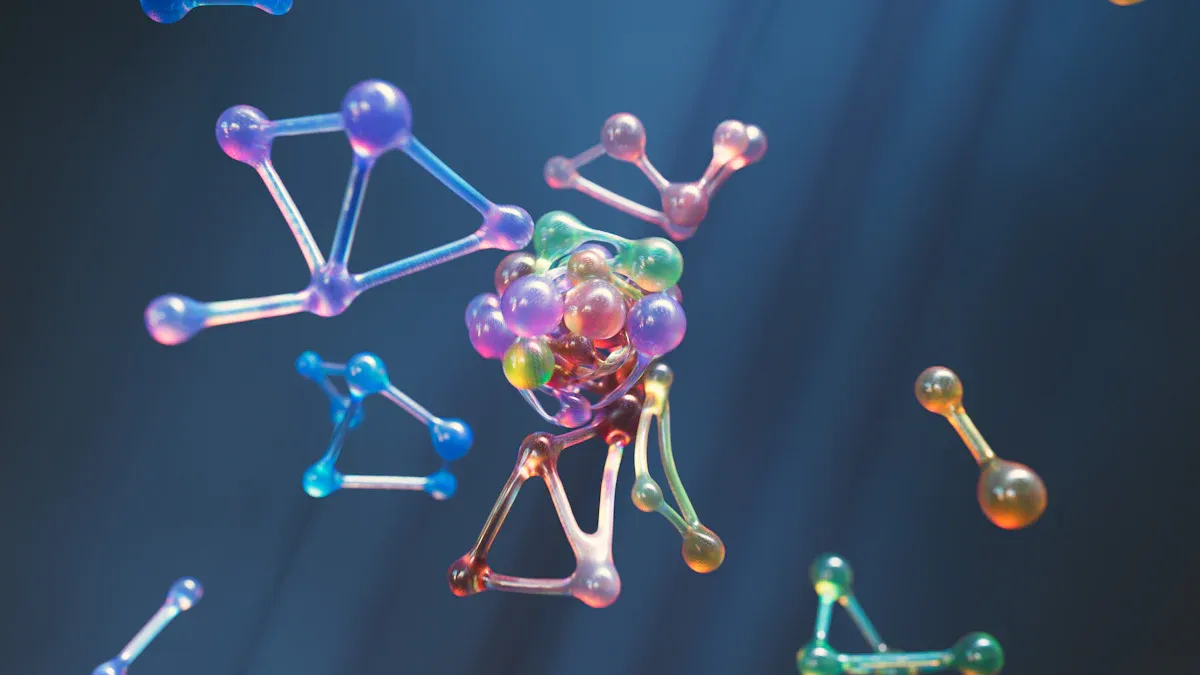News & Events
MBP Fusion Strategies for Improved Parathyroid Hormone Protein Solubility

You may find it difficult to express soluble parathyroid hormone protein in recombinant systems. Common challenges include:
- Proteolytic degradation by intracellular enzymes
- The need for effective fusion partners to boost solubility and stability
- Careful selection of proteases to avoid unwanted cleavage
Using MBP as a fusion tag helps you overcome these problems. You gain enhanced protein solubility, high yields in E. coli, and straightforward purification with amylose resin. This approach also protects your protein from degradation and allows easy removal of the tag after purification.
Key Takeaways
- Using MBP as a fusion tag greatly improves the solubility of parathyroid hormone, making it easier to study and use in research.
- MBP fusion increases protein yields in E. coli, allowing you to produce more parathyroid hormone in each batch.
- The MBP tag protects parathyroid hormone from degradation, ensuring that the protein remains stable and functional.
- Purification with amylose resin is straightforward, allowing for easy recovery of your target protein after expression.
- Always test the biological activity of parathyroid hormone after removing the MBP tag to ensure it retains its function.
MBP Fusion Benefits
Parathyroid Hormone Protein Solubility
You often face problems with the solubility of parathyroid hormone in research and industry. The parathyroid hormone protein tends to form clumps, which makes it hard to study or use in medicine. When you use a fusion method with maltose binding protein (MBP), you can solve many of these problems. MBP attaches to the parathyroid hormone at the N-terminus. This helps keep the structure stable and prevents the protein from sticking together.
Tip: MBP fusion works well for parathyroid hormone because it does not cause dimerization. This is important for experiments that need single, well-behaved proteins.
You can see how the MBP fusion method improves solubility in the following steps:
| Step | Description |
|---|---|
| 1 | Fusion of MBP to the N-terminus of PTH1R ECD for stability. |
| 2 | Purification using Ni-NTA beads after cell lysis. |
| 3 | Disulfide reshuffling reaction to enhance protein quality. |
| 4 | Final concentration and storage of pure protein. |
MBP fusion also helps with crystallization. This is useful when you want to study the structure of parathyroid hormone or its receptor. Unlike GST, MBP does not form dimers, so you get better results for structure studies.
You may wonder how MBP compares to other fusion tags. MBP stands out because:
- MBP increases solubility without causing unwanted binding or dimerization.
- GST can dimerize, which may not work for all proteins.
- MBP is larger than GST, which can help with small proteins but may not suit very large ones.
- MBP binds to amylose resin, making purification easy. You can use maltose to elute your protein.
Expression Yield
When you use MBP fusion, you get higher yields of parathyroid hormone. This means you can produce more protein in each batch. In E. coli strains, MBP fusion leads to efficient expression. For example:
- The Rosetta-gami strain gives you up to 60% target protein, while BL21 gives only 25%.
- You can collect up to 18.5 mg/ml of pure fusion protein from just one liter of culture.
The table below shows how MBP fusion improves yield and stability for different peptides, including PTH:
| Peptide | Expression with CASPON™ Tag | Expression without Tag | Stability |
|---|---|---|---|
| PTH | Improved | Degradation observed | Higher yield |
| SST | Improved | Degradation observed | Higher yield |
| PLEC | Improved | Degradation observed | Higher yield |
| BPTI | Improved | Degradation observed | Higher yield |
You can scale up production for research or industry. MBP fusion protects parathyroid hormone from breaking down, so you get more stable protein. This is important for studies on bone health, calcium balance, and parathyroid function.
Note: MBP fusion makes purification simple and reliable. You can use amylose resin and maltose for easy recovery of your protein.
By choosing MBP fusion, you improve both the solubility and yield of parathyroid hormone. This helps you study its role in bone and calcium regulation, and supports research on its structure and binding to receptors.
Parathyroid Hormone Protein Expression Challenges

Aggregation Issues
You may notice that parathyroid hormone often forms clumps when you try to produce it in a lab. This happens because the protein has a delicate structure. If the folding does not happen correctly, the protein sticks together and becomes insoluble. You face this problem when you use recombinant expression systems. Several factors can make aggregation worse:
- Molecular chaperones help proteins fold the right way. If you do not have enough chaperones, the protein may form inclusion bodies.
- Chemical additives in the culture media can cause osmotic stress. This stress leads cells to make osmolytes, which help stabilize proteins.
- The structure of parathyroid hormone depends on proper disulfide bond formation. Specific chaperones help with this process and keep the protein soluble.
You can use fusion methods to attach MBP or other tags to parathyroid hormone. This helps the protein fold better and reduces aggregation. When you improve folding, you get more soluble protein for your studies.
Impact on Function
When parathyroid hormone forms aggregates, its biological activity drops. You need the protein to stay in the right shape to work well. Parathyroid hormone controls calcium and phosphate levels in your body. If the protein aggregates, it cannot bind to its receptor, PTH1R, and loses its function. This affects bone health and calcium balance.
You may see these problems in downstream applications:
- Aggregation changes the structure of parathyroid hormone and reduces its ability to activate PTH1R.
- Oxidation and aggregation can make the protein less effective in research and medicine.
- The stability of parathyroid hormone formulations is important for safety and efficacy. If the protein aggregates, you may see lower activity and more side effects.
- High concentration, pH, and ionic strength can increase aggregation. You need to control these factors during production.
- Fibrillar aggregation and gelation can lower the pharmacological activity of therapeutic peptides.
You can improve the stability and function of parathyroid hormone by using fusion methods and optimizing folding. This helps you get reliable results in bone and calcium studies.
MBP Fusion Tag Mechanism

Solubility Enhancement
You often struggle with the solubility of parathyroid hormone in laboratory settings. The maltose binding protein acts as a powerful solubility enhancer when you use it as a fusion partner. At the molecular level, MBP helps your protein in several ways:
- It creates an electrostatic shield around the parathyroid hormone. This shield reduces the chance that the protein will stick to itself and form clumps.
- MBP can form soluble aggregates. Its hydrophilic surface covers the hydrophobic parts of the parathyroid hormone, keeping it dissolved in solution.
- The fusion acts as an entropic anchor. It limits the movement of the protein, which helps it fold into the right shape.
- MBP interacts with natural chaperones in the cell. These chaperones help the parathyroid hormone protein fold correctly and stay soluble.
MBP works like a “holdase.” It keeps the parathyroid hormone from forming insoluble clumps. This gives the protein time to fold properly, either on its own or with help from chaperones.
You get the best results when you attach MBP to the N-terminus of the parathyroid hormone. This method lets MBP fold first, which helps guide the rest of the protein into the correct structure. You see fewer aggregates and more soluble protein, making purification much easier.
Parathyroid Hormone Receptor Applications
You need soluble parathyroid hormone for studies on bone and calcium regulation. MBP fusion helps you express and purify the parathyroid hormone protein in a form that keeps its natural structure. This is important for research on the parathyroid hormone receptor.
Researchers have used MBP fusion to produce the N-terminal extracellular domain of the parathyroid hormone receptor. This domain binds to PTH, which allows you to study how the hormone interacts with its receptor. You can use this method to prepare samples for crystallization and structural analysis. These studies help you understand how parathyroid hormone controls bone health and calcium balance.
When you use MBP fusion, you make it possible to study the binding between parathyroid hormone and its receptor. This supports research on new treatments for bone diseases.
You can rely on MBP fusion to improve expression, purification, and structural studies of parathyroid hormone and its receptor. This approach gives you the tools to explore how these proteins work together in the body.
MBP Fusion Expression and Purification
Construct Design
When you design a fusion construct for parathyroid hormone, you need to focus on several important factors. The right design helps you get high solubility and good yields. Here are some key points to consider:
- Choose a strong promoter for high expression of your fusion protein.
- Attach maltose binding protein (MBP) to the N-terminus of parathyroid hormone. This position improves solubility and helps with purification.
- Use a flexible linker between MBP and parathyroid hormone. A well-designed linker reduces conformational heterogeneity and allows the protein to fold correctly.
- Helical linkers can help you position the parathyroid hormone in different ways. This can improve your chances of getting good crystals for structure studies.
- The large size and hydrophilic nature of MBP help keep the fusion protein soluble.
- Add a His6 tag at the C-terminus. This tag gives you another way to purify your protein.
You can see how different host strains affect expression in the table below:
| Host Strain | Expression Level |
|---|---|
| TB1 | Highest expression |
| BL21 (DE3) | Moderate expression |
| BL21 (DE3) pLysS | Moderate expression |
| Top10 | Lower expression |
You should also optimize key parameters during expression. For example, low temperature helps you get full-length protein and improves solubility. MBP acts like a chaperone, protecting your parathyroid hormone from breaking down and helping it fold the right way. Oxidizing conditions can also help by inactivating proteases that might degrade your protein.
| Parameter | Effect on Solubility and Yield |
|---|---|
| Low Temperature | Critical for generating full-length protein, enhancing solubility and stability. |
| Chaperone-like qualities of MBP | Protects against proteolysis, enabling optimal folding and potential disulfide formation. |
| Oxidizing Conditions | May increase yields by inactivating degrading proteases, thus preserving protein integrity. |
Amylose Resin Purification
After you express your MBP-parathyroid hormone fusion, you need to purify it. Amylose resin gives you a simple and effective way to do this. MBP binds strongly to amylose resin, so you can capture your fusion protein from the cell lysate. You then wash away unwanted proteins and elute your target protein using maltose.
The His6 tag at the C-terminus gives you another purification step. You can use immobilized metal affinity chromatography (IMAC) to make sure you isolate the full-length protein. This two-step method for expression and purification helps you get a pure product for your studies on bone and calcium regulation.
Here is a typical workflow for purification:
- Lyse the cells and collect the supernatant.
- Load the supernatant onto amylose resin. MBP-parathyroid hormone binds to the resin.
- Wash the resin to remove non-specific proteins.
- Elute your fusion protein with a buffer containing maltose.
- Use IMAC with the His6 tag for further purification if needed.
Tip: Sometimes, you may have trouble eluting your fusion protein from amylose resin, even with high maltose concentrations. You might also see unwanted proteins in your elution. If this happens, check your buffer conditions and make sure your fusion protein is not degraded.
Tag Removal
Once you have purified your MBP-parathyroid hormone fusion, you may want to remove the MBP tag. This step is important if you need the native form of parathyroid hormone for functional studies or pth binding assays.
You can use a specific protease to cut between MBP and parathyroid hormone. After cleavage, you can separate the tag from your target protein using another round of purification. For example, you can use amylose resin again to bind the free MBP, while your parathyroid hormone flows through.
To check the quality of your final product, you should run a western blot or SDS-PAGE. This helps you confirm the size and purity of your parathyroid hormone protein. High-quality protein is important for studies on bone health, calcium balance, and receptor binding.
Note: Always choose a protease that does not cut inside your parathyroid hormone sequence. This keeps your protein intact and functional.
By following these steps, you can use the MBP fusion method for expression and purification of parathyroid hormone. This approach gives you a reliable way to study the structure and function of this important protein.
Limitations and Troubleshooting
Drawbacks of MBP Fusion
When you use MBP as a fusion tag for parathyroid hormone, you may face some challenges. Here are the most common drawbacks:
- The MBP tag can change the structure or function of parathyroid hormone. This may cause a loss of activity, which is important for pth binding and studies on bone health.
- Removing MBP after purification can make parathyroid hormone unstable. This can create problems if you need the protein for crystallization or other research.
- The process of removing the MBP tag adds extra steps to your method for expression and purification. These steps can take more time and may lower your final yield.
- MBP and its linker add non-native sequences to parathyroid hormone. These extra parts might affect the therapeutic use of the protein or cause an immune response.
You should always check if MBP fusion is the best choice for your project. Sometimes, you may need to try other tags or methods to get the best results for your bone and calcium studies.
Low Solubility Solutions
If you still see low solubility or poor expression of your MBP-parathyroid hormone fusion, you can try several solutions:
- Co-express molecular chaperones. These helper proteins assist in folding and keep parathyroid hormone soluble during expression.
- Use fusion partners like MBP that help prevent aggregation. MBP can bind to parts of parathyroid hormone that tend to clump together.
- Try different fusion tags that act as folding helpers. Some tags can serve as nucleation sites, helping parathyroid hormone fold the right way.
You can also improve solubility during purification by using the right buffer. The table below shows buffer conditions that help keep MBP-parathyroid hormone fusion proteins soluble:
| Buffer Components | Concentration |
|---|---|
| Tris-HCl | 50 mM, pH 8.0 |
| Glycerol | 5% (vol/vol) |
| NaCl | 150 mM |
| Maltose | ~3 mM |
| GSH | 5 mM or 1 mM |
| GSSG | 1 mM |
You should test these conditions to find the best method for your protein. If you still have trouble, try lowering the temperature during expression or changing the host strain. These steps can help you get more soluble parathyroid hormone for your bone and calcium research.
You can boost parathyroid hormone protein solubility by using MBP fusion. This method prevents inclusion bodies and helps your protein fold and stay stable. Recent research shows that MBP fusion works better than other tags, making it easier to study bone health. You should try new purification tools, like the DARPin matrix, for higher yields. For tough proteins, optimize your tag design and test new mRNA strategies. These steps help you get more soluble protein for your bone research.
FAQ
What is MBP and why do you use it for parathyroid hormone protein?
MBP stands for maltose binding protein. You use MBP as a fusion tag because it helps parathyroid hormone protein stay soluble and stable during expression and purification.
Can you remove the MBP tag after purification?
Yes, you can remove the MBP tag with a specific protease. This step gives you the native parathyroid hormone protein for your experiments or studies.
Does MBP fusion affect the biological activity of parathyroid hormone?
MBP fusion can sometimes change the activity of parathyroid hormone. You should always test the function of your protein after removing the MBP tag to make sure it works as expected.
What host strains work best for MBP-parathyroid hormone expression?
You get the highest expression in TB1 strains. BL21 (DE3) and BL21 (DE3) pLysS also work well. You should test different strains to find the best one for your needs.
How do you check the purity of your MBP-parathyroid hormone protein?
You can use SDS-PAGE or western blot to check purity. These methods show you if your protein is the right size and if it is free from unwanted proteins.

